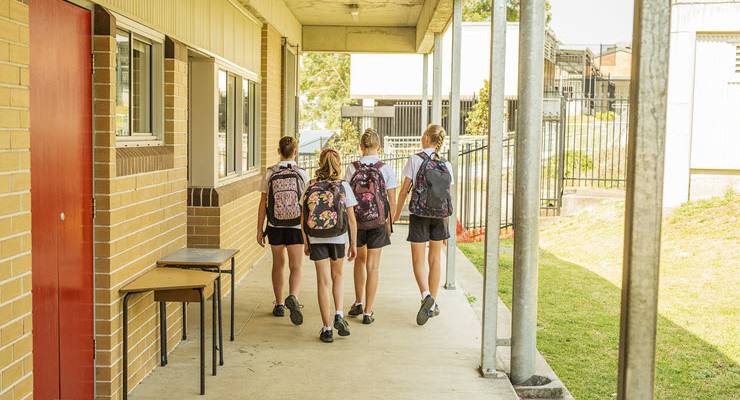
Imagine every seat in the Melbourne Cricket Ground — the nation’s biggest sporting stadium — being filled. A stadium packed to capacity with 100,000 fans.
Now imagine if every one of those seats was filled by a child, representing the number of children not enrolled in any school system in Australia.
That number increased from fewer than 40,000 in 2017, to 50,000 a couple of years ago, and now, according to experts, could be anywhere up to 100,000.
By every measure this is a disgrace, a crisis, a public policy failing, and a damn travesty.
University of Melbourne Graduate School of Education’s Professor Jim Watterston doesn’t mince words.
“We don’t know who they are or where they are. We just know they are lost,” he told Crikey. “It turns us into a third-world country when it comes to education.”
He’s right. In a week when thousands of students in several states are signing off on their final Year 12 exams, no attention is on those who are “detached” totally from school, or not even enrolled.
Watterston’s work, with co-author Megan O’Connell, was conducted a couple of years ago when evidence suggested 50,000 students were no longer part of the school system. That was a jump of 12,000 on OECD figures in 2017.
But Watterston says data around pandemic lockdowns in particular, along with advice from educators, suggested the figure could now be as high as 100,000.
“That’s a reasonable estimate,” he says.
A senior school head in Victoria told Crikey those numbers were entirely plausible and suggested that while no one would know the true extent, schools were seeing a decline in those enrolled post-COVID.
Watterston says separate research involving school principals in different states showed that up to one in five students couldn’t or wouldn’t engage during lockdown classes due to a host of reasons, including a lack of direction and IT issues.
So if we know that during lockdowns many students stopped engaging in digital learning, and some of them have never returned, what are we doing about it?
We know that the mental health crisis that stole social and emotional growth opportunities from our teens is an ongoing legacy of a pandemic that none of us predicted. But what is being done?
Watterston’s hope reflects that of many who hold education policy dear: that a new federal inquiry into “school refusal” could be broadened, or find a way to explain a trajectory that will follow the nation into the next generation.
That recently announced inquiry is being held by the Senate Education and Employment References Committee into another national trend: that of “school refusal”, where a student simply refuses — often with emotional distress — to walk through the school gates each morning.
Certainly, this has escalated during COVID-19, and school leaders say it is enveloping children in lower primary school through to Year 12.
But those children refusing to attend are enrolled. Watterston’s research highlights those children who are “detached” or not enrolled in any form of school education.
That means they are not simply absent. They might never have been enrolled, or had fallen out of the system as they’ve been expelled or moved away. Or perhaps they didn’t “fit” a school system that cherishes academic performance and strict behavioural codes.
The problem is, as Watterston and educators point out, we simply don’t know.
The Senate inquiry’s terms of reference traverse the impact of COVID-19 on school refusal, its impact on students, families and services, and how relevant state and Commonwealth policy is addressing it.
All of that is utterly commendable, but it would be a missed opportunity not to also look at those who are not only refusing to attend school but who are simply lost to the system.
We need to know if there is any crossover, and where and why it is happening.
Despite the warning issued by Watterson’s research two years ago, nothing has really been done to answer the question: where are these children?
Now we find out that the numbers have continued to decline, and have possibly almost doubled.
And that points to a big red “fail” mark.
Are we failing our kids? How do we reverse this trend? Let us know your thoughts by writing to letters@crikey.com.au. Please include your full name to be considered for publication. We reserve the right to edit for length and clarity.








Could we have some basic detail here, please?
Like what age groups does this affect?
Is this mostly kids who are old enough not to be in school legally, but “should” be or are we talking about kids under 10 … or what?
Very hard to tell from this vague piece what the nature of the problem is. Or how it was defined.
How can we know 100K kids are missing, but also not know where they are? How was this number arrived at?
well, the LNP need to get there voters from somewhere
Do you count officially home educated children (those registered with their state education authority) in these numbers of kids not at school? They may number up to 1% of school aged children, and they are (on the whole) getting at least as good an education as they could at school (I know ours did, none of which attended school until year 11, and even then largely so they could get an ATAR). There are also a large number of unregistered home educated children, and it’s true they have no oversight from any education regulators.
Last I heard education was compulsory in this country. Where’s the implementaion? Scandalous dereliction of duty by our Public Service, or more likely by those supposed to be funding them to do their jobs.
Have seen many families travelling around Oz, so they may be part of that cohort not counted. Claim they learn more ‘on the road’ (which is fine for a while), but maybe not for more than 6 months to one year. Due to lockdowns thisI situation has increased, as parents learnt to supervise home schooling.